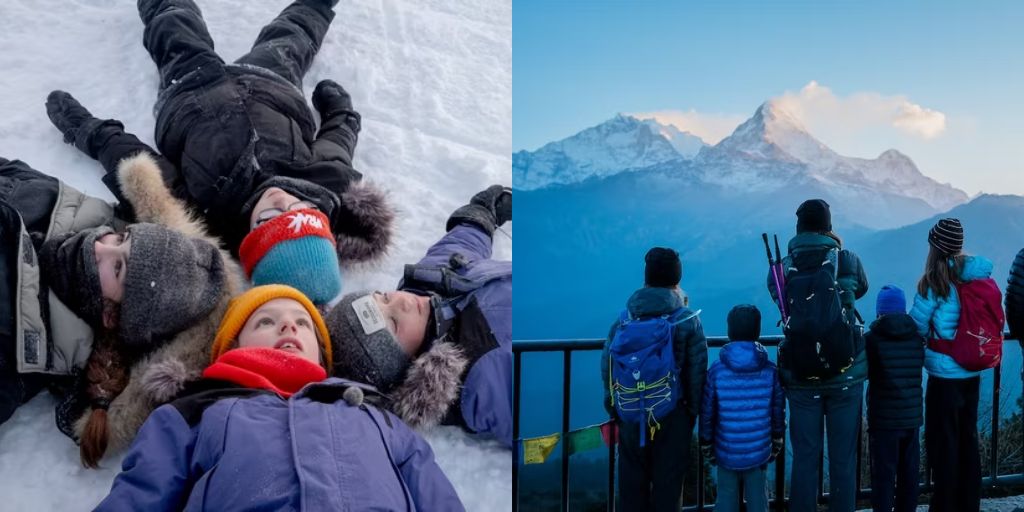In recent years, I have dealt with serious eye problems that almost caused me to go blind. Some people may find it strange that a film critic struggles with vision loss, seeing it as a twist of fate. Just days before surgery to fix the damage from a previous operation, I watched Avatar: The Way of Water in an IMAX theater.
During the movie, I realized that I might never see a 3D film again. While some people might prefer that, I felt a strong need to remember every visual detail of the experience. I wanted to hold on to it in case I lost my sight in one eye forever, and I still worried about my other eye being affected next.
This feeling of actively seeing to create memories stayed with me as I watched Blink. This touching yet entertaining film tells the story of the Pelletier family, who took their curious children on a global adventure. The parents aimed to give their kids unforgettable memories from their incredible experiences.
Unfortunately, the urgency of this trip is linked to events that will soon affect several children’s abilities to see these sights in the same way.
What Is ‘Blink’ About?
Blink tells the story of how Edith and Sébastien Pelletier planned a world trip with their children, three of whom have an incurable illness called retinitis pigmentosa. This condition will take away their sight over the next few years. Mia, the oldest child and only girl, is a book-loving pre-teen who loves to dance alone.
Léo, the oldest boy, leads his brothers and shows great determination. Colin, the middle child, is quiet and reserved, and Laurent, the youngest, experiences strong emotions and knows something is wrong but cannot understand what losing his sight means.
The opening scene shows the family in a northern area, trying to see the aurora borealis. At first, we hear the children’s complaints about not seeing the beautiful Northern Lights that the camera captures.
After the trip, Edith explains in an interview that three of her children have this eye condition that gradually takes away their sight, like an iris slowly closing. As the retina cells break down, their vision narrows until they eventually go completely blind.
The first loss is night vision. This changes our understanding of the children’s complaints and helps us connect with their struggles. Other scenes, like a stubborn game of soccer, show what these children are experiencing as their sight fades, helping us understand the parents’ desire to give their family unforgettable experiences.
The Pelletier family’s journey does not focus on what they are losing but on making the most of their time together. There is a saying inspired by Tennyson that suggests it is better to have seen and then become blind than never to have seen at all.
It is easy to interpret this adventure as a panic about disabilities, and some moments about how other senses might improve as sight goes away come close to romanticizing what these kids will face. However, the filmmakers, along with Edith and Sébastien, avoid falling into this trap.
The film does not shy away from moments of doubt or discomfort. Even though there is sadness about the trip’s purpose, there is always joy during their challenging journeys.
Daniel Roher and Edmund Stenson Make ‘Blink’ Extraordinary
The skillful way of balancing these elements is not surprising when the names Daniel Roher and Edmund Stenson appear in the credits. They previously worked together on the Oscar-winning film Navalny, with Roher as the director and Stenson as the editor.
As co-directors of Blink, they present the Pelletier family’s story with nuanced and sophisticated filmmaking that raises it above typical family dramas.
While not every moment of the trip is captured by a camera crew, viewers still experience stunning landscapes and dreamlike locations. The trip was partially based on a list of must-do activities, such as drinking juice on a camel and meeting monkeys.
The family checks off these experiences as they travel across continents, from jungles to deserts and mountains to valleys. They create deep memories for themselves while allowing viewers to share in their adventure.
Not everything goes as planned. The family faces challenges, like being cold on a hill in Nepal and getting stuck in a gondola. These moments add drama, revealing the children’s frustrations and the parents’ patience. The film invites viewers to share in the anxieties, knowing everything will turn out fine in the end.
However, in many ways, not everything works out perfectly. Just as darkness creeps in while they are in the gondola, the film gently reminds us that all the beautiful sights may soon be taken away from the children. On a deeper level, there is a meaningful commentary about human nature.
We celebrate the present while knowing that all will eventually be lost, whether from blindness or death. As people, we often manage to rise above the fear of loss and enjoy what is in front of us.
‘Blink’ Is a Journey Not to Be Forgotten
Perhaps it was the train travel or the brothers’ playful arguments that reminded me of Wes Anderson’s film The Darjeeling Limited, another colorful journey filled with highs and lows experienced by a different family. Both films balance sadness and beauty, highlighting the wonders of the journey while acknowledging the underlying theme of loss that inspired the trip.

This deeper understanding of what it means to live fully gives Blink its unique charm. It becomes more than just a family travel story. Not everyone can experience such a journey, and no one would trade their children’s blindness for a reason to travel.
As viewers, we share the Pelletier family’s ups and downs. We recognize what drives their desire to show the world, reminding ourselves to seize the moment and create good memories whenever we can.




